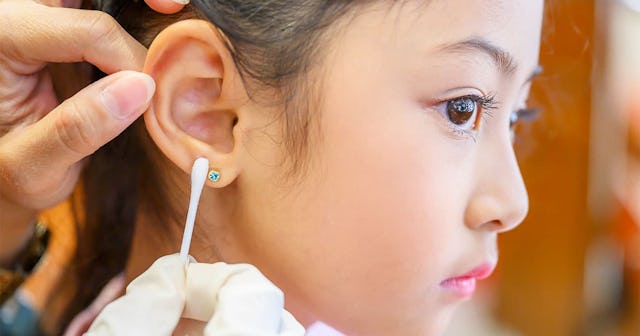5 Things To Know Before Your Child Gets Their Ears Pierced

When I was pregnant with my daughter in the winter of 2012, people asked me a lot of questions, but the most common question wasn’t about my baby’s sex or due date, it was whether or not I was planning to pierce her ears. Yes, really. Of course, I know that sounds strange. Why would anyone ask an expectant mother about infant ear piercing, but to understand the reasoning behind the question, you have to know me, i.e. I have purple hair and blue tips. My septum is pierced, my ears are punched, and my arms and legs are covered in tattoos.
I am something of a poster child for body modification.
And yet, my answer took many by surprise. “No,” I said. “Absolutely not.”
The reason? Well, I wanted to wait to pierce my daughter’s ears because (1) ear piercing was not (is not) of cultural importance to me, (2) because I wanted to make sure the choice was hers, and hers alone, and (3) because I wanted — and still want — to take her to a trained professional. Yes, I plan to take my daughter to a body piercing salon or tattoo studio. Here’s why.
1. You should pierce your child’s ears with a needle and not a “gun.”
ZenShui/Frederic Cirou/Getty
Since the advent of the piercing gun, millions of individuals have been pierced in malls across America. (My lobes were done in Claire’s.) But just because the piercing gun is prevalent does not mean it is ideal, or safe.
“Piercing guns are made of plastic, and cannot be sterilized,” Infinite Body Piercing explains. “While the cartridges that fit in the gun are single-use, the gun itself is capable of sharing disease-causing pathogens between clients.” The method also causes unnecessary pain and trauma.
“Piercing gun studs are blunt, and make their way through the earlobe with brute force,” Infinite owner James Weber writes. “This not only results in a more painful piercing, but also in more trauma that can make healing more difficult.”
As such, parents (and clients) should seek out a shop which uses single-use, hollow point needles.
2. Ear piercings — like all body piercings — should only be performed by trained professionals, not mall staff.
While many popular “piercing” establishments promote themselves (and their staff) as “trained and experienced specialists,” the details of said training are vague. Instead, seek out a piercer who is CPR and First Aid certified, trained in bloodborne pathogens and is a member of the Association of Professional Piercers.
3. Professional body piercers will require consent, which is imperative and helps your child develop a sense of body autonomy.
PhotoAlto/Ale Ventura/Getty
This point may seem obvious, but it is arguably the most contentious. After all, it is “just an ear piercing.” However, letting a child decide if and when they want their ears pierced (or any part of their body pierced) is imperative. It gives them control of their appearance, ownership of their body, and teaches them their wants and desires matter. It also reaffirms two age old mantras, “no means no” and “my body, my choice.” That said, statutes on tattooing and piercing for minors vary from state to state. Check with your local shop for age restrictions and/or requirements.
4. Trained professionals use quality jewelry, not “gold-plated” crap.
While you’ve likely seen sterling silver and gold-plated studs on display at your local piercing “studio” (or, cough cough, kiosk in your mall), these materials are not suitable for initial piercings. Why? Because the metal is too soft and can cause allergic reactions. Instead, the Association of Professional Piercers recommends only using materials which meet ASTM and/or ISO implantation standards, including implant-grade steel, implant-grade titanium, niobium, solid 14k gold, and unleaded glass. Jewelry should be internally threaded or, when possible, threadless.
5. They can also teach you the right way to care for your piercing (because you totally shouldn’t be touching it or turning it).
Piercing aftercare has changed a lot since I was a kid. I was told to clean my stud (and hole) with a Q-tip and rubbing alcohol. The teenager at Claire’s also advised me to turn it on a regular basis, but these suggestions aren’t just outdated, they are wrong.
“There is no single cleaning solution or aftercare regimen that works for everyone, everywhere, all the time,” Infinite Body Piercing explains. Different bodies and different lifestyles demand different aftercare… [and] differences in air and water quality, diet, and climate can greatly affect healing.” However, new piercings should generally be cleaned twice daily, through Infinite’s aftercare guide also notes the frequency of cleanings may vary, depending on “your skin type, your daily activities and environment, and what piercing you are trying to heal.”
As for what you should be cleaning your piercing with, soap and water is best. Salt water and/or saline solutions can also be used to irrigate your piercing.
“Continue this cleaning routine for the entire healing period but do not over-clean your piercing. Cleaning too often with an overly harsh cleaning solution, or with too many different types of cleaning solutions, can irritate your piercing.”
Oh, and steer clear of any product which promises “rapid healing.” No such solution exists, and changing your piercing too early — which these products imply you can do — puts you at risk.
As for my daughter, she has started to inquire about getting her ears pierced, and I’ve told her I will happily take her if and when she is ready — not to the mall, but to a professional. To a place which pierces everything from children’s earlobes to teenage nostrils, navels, and woman’s genitalia.
This article was originally published on